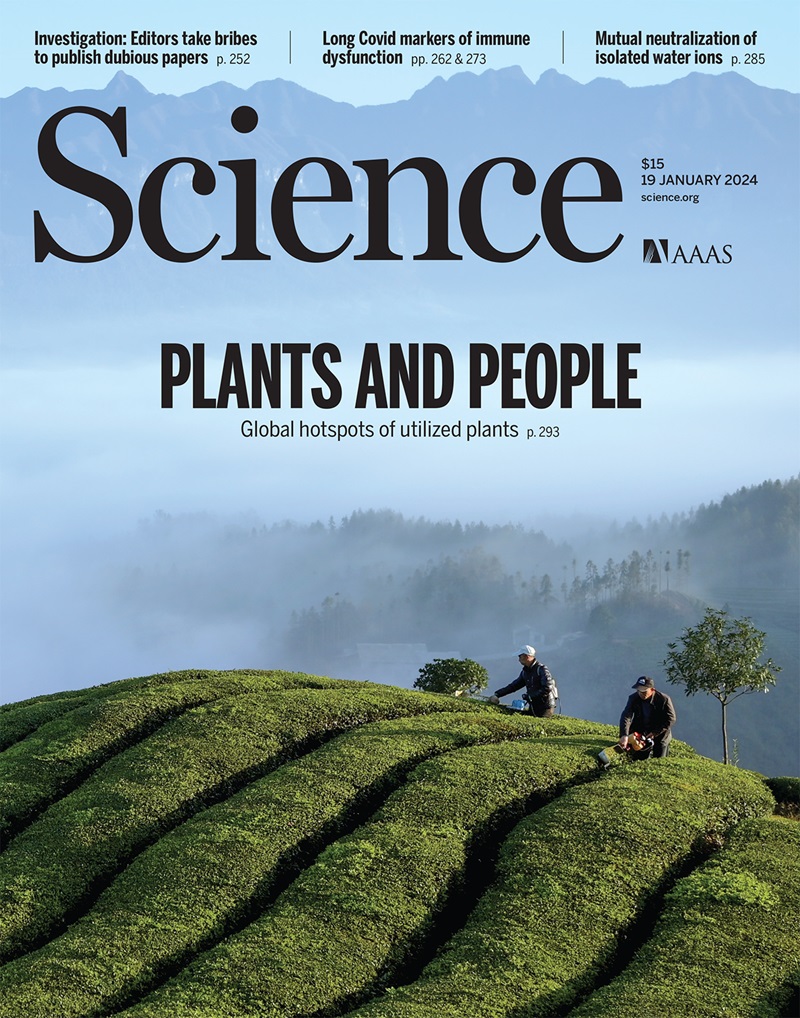细菌逆转录酶合成富含多聚a的长cDNA用于抗噬菌体防御
IF 45.8
1区 综合性期刊
Q1 MULTIDISCIPLINARY SCIENCES
引用次数: 0
摘要
原核防御相关逆转录酶(DRTs)最近被发现具有抗病毒功能;然而,它们的功能机制在很大程度上仍未被探索。本研究表明,DRT9与其上游非编码RNA (ncRNA)形成六聚体复合物,通过流产感染诱导细胞生长停滞,介导抗噬菌体防御。在噬菌体感染后,噬菌体编码的核糖核苷酸还原酶NrdAB复合物升高细胞内dATP水平,激活DRT9合成长且富含多聚a的单链cDNA,这可能会隔离噬菌体必需的SSB蛋白并破坏噬菌体的繁殖。我们进一步确定了DRT9-ncRNA六聚体复合体的低温电镜结构,为其cDNA合成提供了机制见解。这些发现突出了基于RT的抗病毒防御机制的多样性,扩展了我们对RT生物学功能的理解,并为开发基于drt9的生物技术工具提供了结构基础。本文章由计算机程序翻译,如有差异,请以英文原文为准。

Bacterial reverse transcriptase synthesizes long poly(A)-rich cDNA for antiphage defense
Prokaryotic defense-associated reverse transcriptases (DRTs) were recently identified with antiviral functions; however, their functional mechanisms remain largely unexplored. Here we show that DRT9 forms a hexameric complex with its upstream noncoding RNA (ncRNA) to mediate antiphage defense by inducing cell growth arrest through abortive infection. Upon phage infection, the phage-encoded ribonucleotide reductase NrdAB complex increases intracellular deoxyadenosine triphosphate levels, activating DRT9 to synthesize long, polyadenylate [poly(A)]–rich single-stranded complementary DNA (cDNA), which likely sequesters the essential phage single-stranded DNA binding (SSB) protein and disrupts phage propagation. We further determined the cryo–electron microscopy structure of the DRT9-ncRNA hexamer complex, providing mechanistic insights into its cDNA synthesis. These findings highlight the diversity of RT-based antiviral defense mechanisms, expand our understanding of RT biological functions, and provide a structural basis for developing DRT9-based biotechnological tools.
求助全文
通过发布文献求助,成功后即可免费获取论文全文。
去求助
来源期刊

Science
综合性期刊-综合性期刊
CiteScore
61.10
自引率
0.90%
发文量
0
审稿时长
2.1 months
期刊介绍:
Science is a leading outlet for scientific news, commentary, and cutting-edge research. Through its print and online incarnations, Science reaches an estimated worldwide readership of more than one million. Science’s authorship is global too, and its articles consistently rank among the world's most cited research.
Science serves as a forum for discussion of important issues related to the advancement of science by publishing material on which a consensus has been reached as well as including the presentation of minority or conflicting points of view. Accordingly, all articles published in Science—including editorials, news and comment, and book reviews—are signed and reflect the individual views of the authors and not official points of view adopted by AAAS or the institutions with which the authors are affiliated.
Science seeks to publish those papers that are most influential in their fields or across fields and that will significantly advance scientific understanding. Selected papers should present novel and broadly important data, syntheses, or concepts. They should merit recognition by the wider scientific community and general public provided by publication in Science, beyond that provided by specialty journals. Science welcomes submissions from all fields of science and from any source. The editors are committed to the prompt evaluation and publication of submitted papers while upholding high standards that support reproducibility of published research. Science is published weekly; selected papers are published online ahead of print.
 求助内容:
求助内容: 应助结果提醒方式:
应助结果提醒方式:


